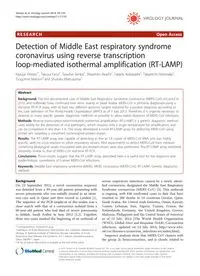
2014 Detection of Middle East respiratory syndrome coronavirus using reverse transcription loop-mediated isothermal ampl PDF
Preview 2014 Detection of Middle East respiratory syndrome coronavirus using reverse transcription loop-mediated isothermal ampl
RESEARCH Open Access Detection of Middle East respiratory syndrome coronavirus using reverse transcription loop-mediated isothermal amplification (RT-LAMP) Kazuya Shirato1*, Takuya Yano2, Syouhei Senba3, Shigehiro Akachi2, Takashi Kobayashi2, Takamichi Nishinaka2, Tsugunori Notomi3 and Shutoku Matsuyama1 Abstract Background: The first documented case of Middle East Respiratory Syndrome coronavirus (MERS-CoV) occurred in 2012, and outbreaks have continued ever since, mainly in Saudi Arabia. MERS-CoV is primarily diagnosed using a real-time RT-PCR assay, with at least two different genomic targets required for a positive diagnosis according to the case definition of The World Health Organization (WHO) as of 3 July 2013. Therefore, it is urgently necessary to develop as many specific genetic diagnostic methods as possible to allow stable diagnosis of MERS-CoV infections. Methods: Reverse transcription-loop-mediated isothermal amplification (RT-LAMP) is a genetic diagnostic method used widely for the detection of viral pathogens, which requires only a single temperature for amplification, and can be completed in less than 1 h. This study developed a novel RT-LAMP assay for detecting MERS-CoV using primer sets targeting a conserved nucleocapsid protein region. Results: The RT-LAMP assay was capable of detecting as few as 3.4 copies of MERS-CoV RNA, and was highly specific, with no cross-reaction to other respiratory viruses. Pilot experiments to detect MERS-CoV from medium containing pharyngeal swabs inoculated with pre-titrated viruses were also performed. The RT-LAMP assay exhibited sensitivity similar to that of MERS-CoV real-time RT-PCR. Conclusions: These results suggest that the RT-LAMP assay described here is a useful tool for the diagnosis and epidemiologic surveillance of human MERS-CoV infections. Keywords: Meddle East respiratory syndrome (MERS), MERS coronavirus (MERS-CoV), RT-LAMP, Genetic diagnostic method Background On 22 September 2012, a novel coronavirus sequence was detected from a 49-year-old patient presenting with severe pneumonia who was initially treated in an inten- sive care unit in Qatar and then moved to London [1]. The sequence of the PCR amplicon of this isolate was a close match with that of a coronavirus isolated from a 60-year-old patient who had died of severe pneumonia in Jeddah, Saudi Arabia in June 2012 [1,2]. Together, these two cases marked the beginning of an outbreak of severe respiratory infections caused by a newly identi- fied coronavirus, designated the Middle East Respiratory Syndrome coronavirus (MERS-CoV) [3]. This outbreak is ongoing, with 836 confirmed cases to date that have resulted in 288 deaths in 19 countries (Jordan, Qatar, Saudi Arabia, the United Arab Emirates, Oman, Kuwait, Yemen, Lebanon, Iran, Algeria, Tunisia, France, the Netherlands, Germany, the United Kingdom, Greece, Malaysia, Philippines and the United States of America) as of 14 July, 2014 [The World Health Organization (WHO), Global Alert and Response (GAR), Coronavirus infections, updated on 14 July 2014, http://www.who. int/csr/disease/coronavirus_infections/en/index.html]. Sequence analyses show that MERS-CoV clusters with the group 2c betacoronavirus, and is closely related to * Correspondence:
